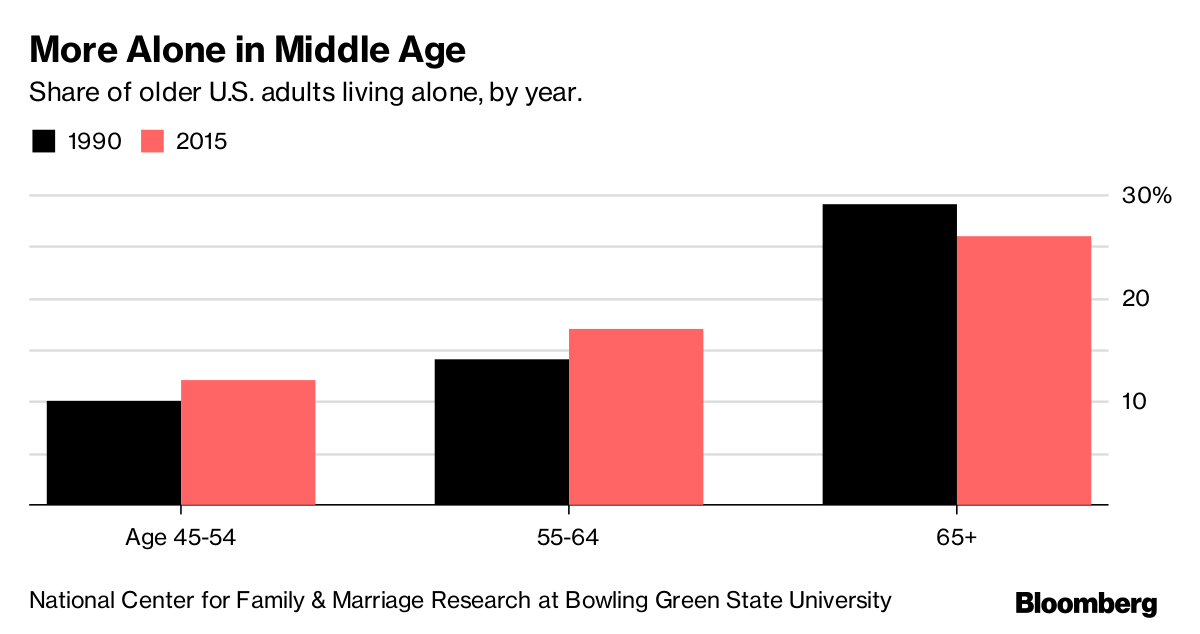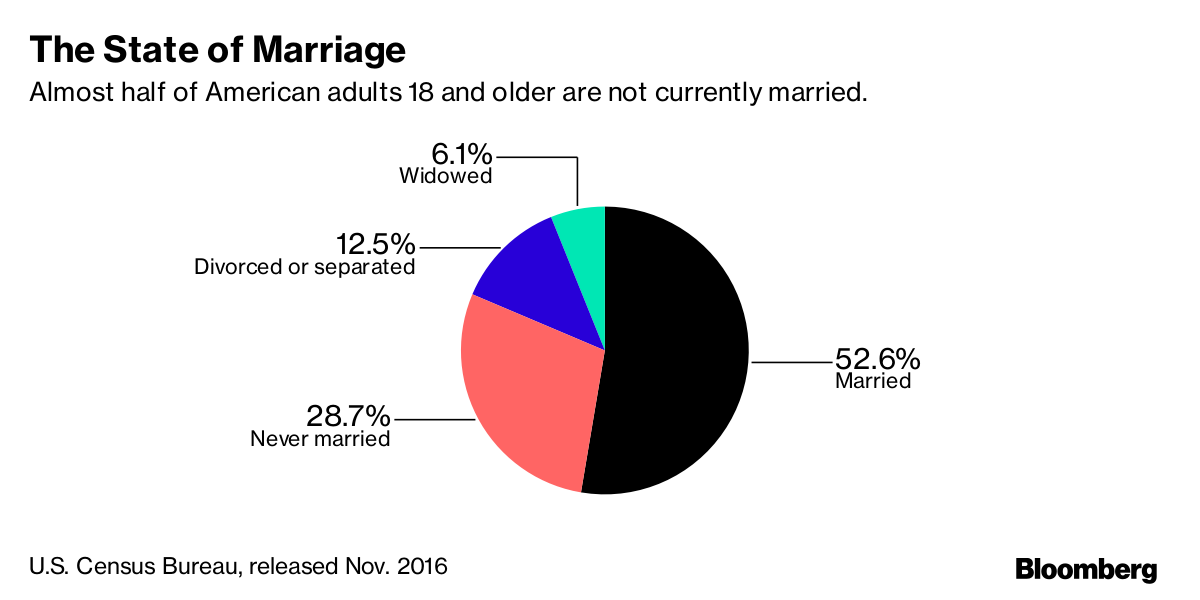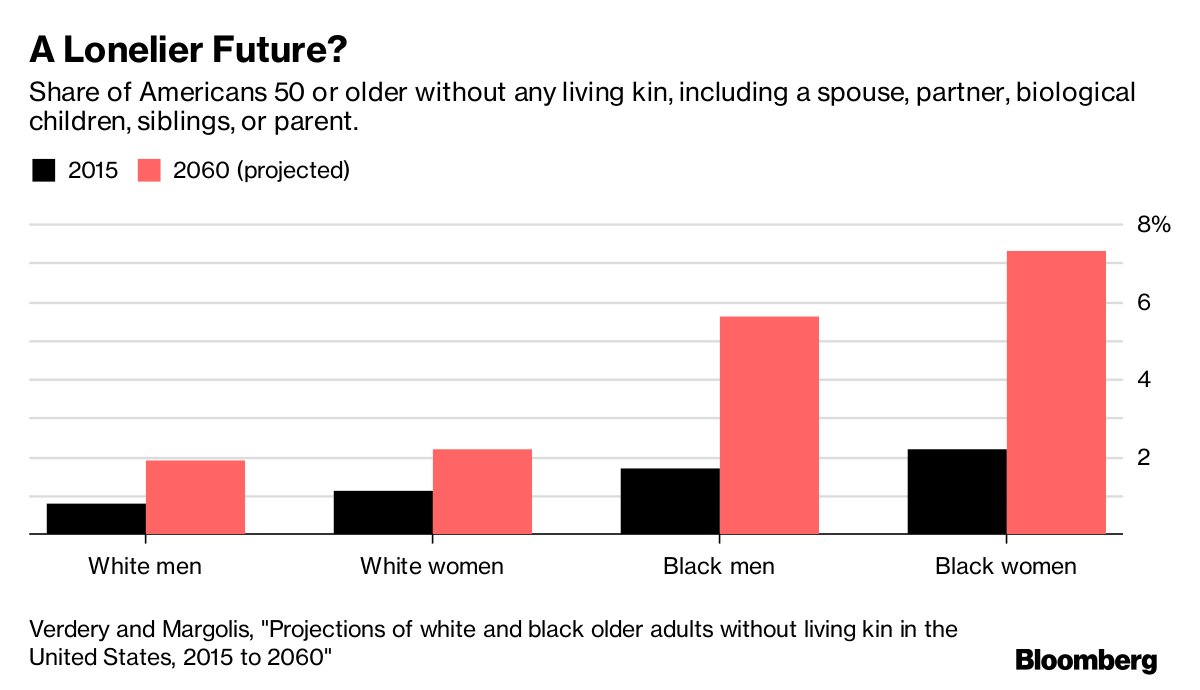Loneliness kills. Life without friends and family is not just dreary but difficult, especially as we get older.
Strong social relationships boost a person’s chances of staying alive by 50 percent, according to a comprehensive 2010 review of 148 studies that followed 309,000 people for an average of 7.5 years. That’s about the same improvement to mortality as the one that comes from quitting smoking.
It’s hard to say whether Americans are lonelier now than in the past. But they’re certainly more independent than ever. Almost half of U.S. adults are now single. Americans are waiting longer to get married, they’re having smaller families, and about half of all marriages still end in divorce.
Researchers are worried about what these trends mean for Americans as they get older. Will seniors of the future get enough support? Or should we prepare for an epidemic of end-of-life loneliness and isolation?
Thirteen percent of U.S. adults were living alone in 2015, according to a recent study by the National Center for Family & Marriage Research. While that’s up only about 1 percentage point since 1990, different age groups are behaving differently. The share of people under 45 living alone hasn’t budged in 25 years. People 65 and over are living alone slightly less often. That’s partly because, thanks to increased longevity, fewer older people are widowed.
Americans aged 45 to 65, though, are increasingly living on their own.

Living alone isn’t the same thing as being lonely, of course. “Most people who live alone and age alone are quite active socially,” said Eric Klinenberg, a New York University sociology professor.
What worries Klinenberg and other sociologists is older people feeling isolated, especially from family members. This is a relatively new problem. “For most of human history, almost all older adults have been part of dense kin networks,” write sociologists Rachel Margolis and Ashton Verdery.
One of the biggest concerns is aging people who have no close living relatives. Margolis, of the University of Western Ontario, and Verdery, of Penn State University, tried to figure out how many Americans fall into this category, analyzing survey data from 1998 to 2010. They found that 6.6 percent of U.S. adults 55 and older have neither a spouse nor biological children still alive. Just 1 percent of older Americans have essentially no relatives at all alive, including a spouse, partner, children, or biological parents or siblings.
Those numbers are expected to rise. The divorce rate for 55 to 64-year-olds more than doubled from 1990 to 2015, the National Center for Family & Marriage Research estimates. Once divorced, people are also remarrying less often.

In the future, seniors will also have fewer children and siblings to call for help. On average, baby boomers grew up in large families, with lots of brothers and sisters. But women today are having far fewer children—the total U.S. fertility rate dropped 26 percent from 1970 to 2015—and more people are growing up as an only child.
In a new study released this month, Verdery and Margolis predict that the number of older Americans without any living kin is about to surge. Using more than 100 years of Census Bureau data to track American families, they project that the share of non-Hispanic whites without any living close kin will double by 2060. The share of non-Hispanic blacks without close kin is expected to more than triple. (Immigration and a lack of data made it difficult to study other racial groups.)

In place of relatives, many people “try to create their own families,” Klinenberg. However, “those networks can be quite fragile.”
To handle these trends, the U.S. needs more and better housing options for older adults, Klinenberg argues. Social mores might also need to change to make sure people—especially men, who are more prone to social isolation—stay connected as they get older. “Our society is evolving quickly, but probably not quickly enough,” he said.

Loneliness kills. Life without friends and family is not just dreary but difficult, especially as we get older.
Strong social relationships boost a person’s chances of staying alive by 50 percent, according to a comprehensive 2010 review of 148 studies that followed 309,000 people for an average of 7.5 years. That’s about the same improvement to mortality as the one that comes from quitting smoking.
It’s hard to say whether Americans are lonelier now than in the past. But they’re certainly more independent than ever. Almost half of U.S. adults are now single. Americans are waiting longer to get married, they’re having smaller families, and about half of all marriages still end in divorce.
Researchers are worried about what these trends mean for Americans as they get older. Will seniors of the future get enough support? Or should we prepare for an epidemic of end-of-life loneliness and isolation?
Thirteen percent of U.S. adults were living alone in 2015, according to a recent study by the National Center for Family & Marriage Research. While that’s up only about 1 percentage point since 1990, different age groups are behaving differently. The share of people under 45 living alone hasn’t budged in 25 years. People 65 and over are living alone slightly less often. That’s partly because, thanks to increased longevity, fewer older people are widowed.
Americans aged 45 to 65, though, are increasingly living on their own.

Living alone isn’t the same thing as being lonely, of course. “Most people who live alone and age alone are quite active socially,” said Eric Klinenberg, a New York University sociology professor.
What worries Klinenberg and other sociologists is older people feeling isolated, especially from family members. This is a relatively new problem. “For most of human history, almost all older adults have been part of dense kin networks,” write sociologists Rachel Margolis and Ashton Verdery.
One of the biggest concerns is aging people who have no close living relatives. Margolis, of the University of Western Ontario, and Verdery, of Penn State University, tried to figure out how many Americans fall into this category, analyzing survey data from 1998 to 2010. They found that 6.6 percent of U.S. adults 55 and older have neither a spouse nor biological children still alive. Just 1 percent of older Americans have essentially no relatives at all alive, including a spouse, partner, children, or biological parents or siblings.
Those numbers are expected to rise. The divorce rate for 55 to 64-year-olds more than doubled from 1990 to 2015, the National Center for Family & Marriage Research estimates. Once divorced, people are also remarrying less often.

In the future, seniors will also have fewer children and siblings to call for help. On average, baby boomers grew up in large families, with lots of brothers and sisters. But women today are having far fewer children—the total U.S. fertility rate dropped 26 percent from 1970 to 2015—and more people are growing up as an only child.
In a new study released this month, Verdery and Margolis predict that the number of older Americans without any living kin is about to surge. Using more than 100 years of Census Bureau data to track American families, they project that the share of non-Hispanic whites without any living close kin will double by 2060. The share of non-Hispanic blacks without close kin is expected to more than triple. (Immigration and a lack of data made it difficult to study other racial groups.)

In place of relatives, many people “try to create their own families,” Klinenberg. However, “those networks can be quite fragile.”
To handle these trends, the U.S. needs more and better housing options for older adults, Klinenberg argues. Social mores might also need to change to make sure people—especially men, who are more prone to social isolation—stay connected as they get older. “Our society is evolving quickly, but probably not quickly enough,” he said.